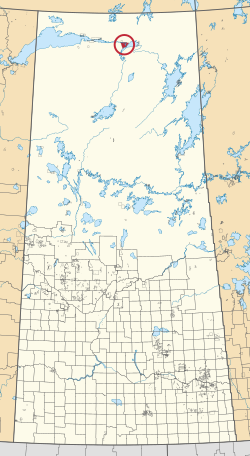Chicken 224 | |
|---|---|
| Chicken Indian Reserve No. 224 | |
 Location in Saskatchewan | |
| First Nation | Black Lake |
| Country | Canada |
| Province | Saskatchewan |
| Area | |
| • Total | 25,819.4 ha (63,801.1 acres) |
| Population (2016)[2] | |
| • Total | 1,379 |
| • Density | 5.3/km2 (14/sq mi) |
| Community Well-Being Index[3] | 42 |
Chicken 224 is an Indian reserve of the Black Lake Denesuline First Nation in Saskatchewan.[1][4] It is 170 kilometres southeast of Uranium City. In the 2016 Canadian Census, it recorded a population of 1379 living in 263 of its 280 total private dwellings.[2] In the same year, its Community Well-Being index was calculated at 42 of 100, compared to 58.4 for the average First Nations community and 77.5 for the average non-Indigenous community.[3]
Etymology
[edit]The three Chicken reserves were named after a Chief Chicken, early leader of the Black Lake band.[5]
See also
[edit]References
[edit]- ^ a b "Reserve/Settlement/Village Detail". Crown–Indigenous Relations and Northern Affairs Canada. Government of Canada. Retrieved 12 August 2019.
- ^ a b "Census Profile, 2016 Census". Statistics Canada. 8 February 2017. Retrieved 10 August 2019.
- ^ a b "The Community Well-Being index". Indigenous Services Canada. 24 May 2019. Retrieved 9 October 2019.
- ^ "Canada Lands Survey System - CLSS Map Browser". Natural Resources Canada. Retrieved 9 October 2019.
- ^ Barry, Bill (September 2005). Geographic Names of Saskatchewan. Regina, Saskatchewan: People Places Publishing, Ltd. p. 82. ISBN 1-897010-19-2.
59°11′56″N 105°37′33″W / 59.1988°N 105.6259°W

Well, that’s interesting to know that Psilotum nudum are known as whisk ferns. Psilotum nudum is the commoner species of the two. While the P. flaccidum is a rare species and is found in the tropical islands. Both the species are usually epiphytic in habit and grow upon tree ferns. These species may also be terrestrial and grow in humus or in the crevices of the rocks.
View the detailed Guide of Psilotum nudum: Detailed Study Of Psilotum Nudum (Whisk Fern), Classification, Anatomy, Reproduction